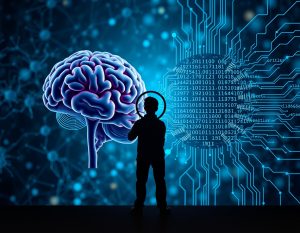Wow, can you believe it? We’re living in a world where AI is no longer just science fiction – it’s in our classrooms, our homes, and even in the palms of our students’ hands! As educators, we’ve got a thrilling (and sometimes daunting) task ahead of us: teaching AI ethics to the next generation. But don’t worry, I’ve got your back! In this ultimate guide, we’ll dive deep into the why, what, and how of integrating AI ethics into K-12 education. Did you know that by 2025, an estimated 97 million new jobs will be created due to AI and automation? That’s right – our students need to be prepared, and it starts with us! So, let’s embark on this exciting journey together and shape the ethical AI leaders of tomorrow!
Why Teaching AI Ethics in K-12 is Crucial
In today’s digital age, the fabric of our daily lives is increasingly woven with strands of artificial intelligence. From the algorithms that curate our social media feeds to smart devices that manage our homes, AI’s integration is not just rapid but also profound—impacting every facet of society. This is exactly why instilling a robust AI ethics framework in K-12 education isn’t just beneficial; it’s imperative.
As we stand on the cusp of a future dominated by AI, preparing students for careers in this dynamic environment becomes crucial. The jobs of tomorrow will not just require technical skills but also a deep understanding of the ethical implications of AI.
How can we expect our young learners to navigate this complex landscape if we don’t equip them today? Teaching AI ethics from an early age ensures that students are not only ready to take on these new roles but also excel in them!
Moreover, the importance of developing critical thinking skills cannot be overstated. When students learn to analyze and question the ethical dilemmas posed by AI, they are sharpening invaluable skills that extend beyond the classroom.
Imagine a generation that doesn’t just passively consume technology but questions and challenges it. By encouraging ethical questioning, we’re cultivating a mindset that values fairness, accountability, and transparency.
Empowering students in this digital era means giving them the tools to not only understand AI but also to influence its trajectory. They are not just users of technology—they are potential innovators and policymakers.
By teaching them about ethical AI design and the moral implications of technology, we are opening doors for them to become leaders who can shape the future of AI development responsibly.
Remember, the goal of education is not just to prepare students for what will come but also to empower them to lead the change they will inevitably be part of. Let’s help them lead it wisely!
Key Concepts in AI Ethics for K-12 Students
When it comes to AI ethics, there are several foundational pillars that can guide K-12 students through the maze of modern technology. These concepts are not just academic; they are crucial life skills for navigating the increasingly AI-infused world around us.
First and foremost, fairness and bias in AI systems are essential topics. Students need to understand that AI, as sophisticated as it might be, often reflects the biases of those who create it. By exploring real-world examples, students can see how these biases can lead to unfair outcomes, and why it’s vital to strive for AI systems that are as unbiased as possible.
Next, we delve into privacy and data protection. In an age where personal information is a hot commodity, knowing how to protect one’s data isn’t just useful—it’s necessary. Students learn the importance of privacy rights and the potential risks associated with the misuse of personal information by AI systems. This knowledge empowers them to make informed decisions about what data they share and the potential consequences.
Transparency and Explainability of AI decisions also take center stage. It’s one thing to use AI, but another to understand how it makes its decisions. Students should be encouraged to question the ‘why’ and ‘how’ of AI judgments, fostering a culture where technology is demystified and made accessible. Understanding these aspects helps students appreciate the importance of developing AI systems that are not only effective but also comprehensible to the average user.
Accountability and responsibility in AI development are critical in ensuring that those who create and deploy AI systems are also responsible for the outcomes. This concept teaches students about the ethical obligation of developers and companies to consider the impact of their technologies. It’s about fostering a sense of responsibility among the future creators and regulators of AI technologies.
Lastly, the social and economic impacts of AI are vast and varied. From changing job landscapes to societal norms, AI’s influence is undeniable. Students need to grasp how AI can both create opportunities and pose challenges to society. Understanding these impacts can inspire them to think critically about how they can contribute positively to a future where AI plays a central role.

Integrating AI Ethics into Different Subject Areas
Introducing AI ethics across various subjects can enrich students’ understanding and foster interdisciplinary connections. Here’s how AI ethics can be woven into the fabric of different educational areas, making it a versatile and relatable topic for students of all interests.
In STEM subjects, the focus can be on exploring the technical mechanics behind AI technologies alongside their ethical implications. Students can engage in projects that build AI models while considering issues like fairness and privacy.
For instance, they could develop a simple machine learning model and then discuss how different data inputs might affect its fairness. This hands-on approach helps demystify the technology and highlights the importance of ethical considerations in technical design.
Social Studies classes offer a fantastic platform to examine the broader societal impacts of AI. Discussions can center around how AI is shaping governance, privacy, surveillance, and social norms.
Students might explore case studies on AI in public policy or the justice system to understand the profound effects these technologies have on society.
Through debates and essays, students can critically analyze how AI influences equality and social justice, offering a comprehensive view of its societal footprint.
In Language Arts, integrating AI ethics can involve analyzing AI-generated content. Students can compare human-written texts to those created by AI, discussing the nuances in creativity, emotional depth, and ethical implications.
This can lead to broader discussions on authorship, copyright, and the authenticity of creative works, encouraging students to think critically about the role of AI in art and literature.
Art classes provide a unique opportunity to visually interpret and express concepts of AI ethics. Students could create projects that depict scenarios involving AI ethics, such as digital collages, paintings, or sculptures that explore themes of AI and human interaction.
These creative endeavors allow students to express their understanding of AI ethics in a personal and impactful way, solidifying their grasp of the subject through artistic expression.
Physical Education might not seem like a natural fit for AI ethics at first glance, but it provides a ground to discuss technology’s role in sports, such as the use of AI for performance analysis or referee decisions.
Debates can be fostered around topics like fairness and the use of AI in enhancing or evaluating physical capabilities, tying back to core ethical questions about equity and fair play in sports.

Age-Appropriate Strategies for Teaching AI Ethics
Teaching AI ethics effectively requires tailoring approaches to different age groups, ensuring the content is both comprehensible and engaging. Here are some age-appropriate strategies that educators can use to introduce students to the complex world of AI ethics:
Elementary School:
At this stage, the goal is to introduce AI ethics through relatable and engaging methods.
· Using storytelling can be a powerful tool. Teachers can tell stories or use picture books that feature scenarios involving robots or AI characters making decisions, helping children understand the concepts of fairness and kindness.
· Simple games can be used to illustrate how decisions made by AI can affect others, instilling basic principles of ethical thinking and empathy in young learners.
Middle School:
Students in this age group are ready to engage more critically with AI ethics.
· Debates provide a dynamic way to encourage students to think about and argue different sides of AI ethical dilemmas, such as the fairness of AI in video games or homework helpers.
· Role-playing scenarios can also be effective, where students act out situations involving AI to explore the consequences of decisions made by AI systems. This hands-on approach helps students understand the complexity of these technologies and their societal impacts.
High School:
Students at this level can handle more sophisticated discussions and projects.
· Case studies of real-world AI applications (like facial recognition or recommendation algorithms) can be analyzed to discuss their ethical implications, encouraging critical thinking and ethical reasoning.
· High school students can also undertake AI ethics projects, where they propose or create ethical guidelines for AI applications or develop presentations that explore ethical dilemmas in technology, preparing them for real-world issues.
Cross-Grade Collaborations & Mentorship Programs:
AI Education Collaborations
• Enhance learning through peer teaching and shared experiences.
• Foster leadership skills and ethical concepts.
• Mentor younger students on AI technologies and ethical implications.
• Activities include joint projects, discussion sessions, and peer-led workshops.
By implementing these age-appropriate strategies, educators can build a comprehensive AI ethics curriculum that grows with their students, preparing them to navigate and shape the technologically advanced world they are inheriting.
Hands-on Activities and Resources for AI Ethics Education
Integrating AI ethics into education can be both exciting and impactful with the right activities and resources. Here’s a guide to practical, hands-on tools that educators can use to bring these important concepts to life for students of all ages.
AI Ethics Simulation Games and Interactive Tools:
These are excellent for making the learning experience engaging and immersive. Simulation games can place students in the role of decision-makers, where they must navigate ethical dilemmas involving AI technologies.
For example, interactive scenarios can challenge students to balance efficiency and privacy when deploying AI surveillance tools in smart cities, helping them understand the real-world implications of these technologies.
Guest Speaker Series Featuring AI Experts and Ethicists:
Inviting professionals who work in AI and ethics can provide students with valuable insights into the challenges and considerations of the field.
These sessions can inspire students and provide a more nuanced understanding of the ethical landscape in AI development.
Speakers can share their experiences, discuss current issues in the industry, and even provide career guidance to students interested in the field.
Student-led AI Ethics Committees and Projects:
Empowering students to lead their own AI ethics projects or form committees can foster leadership and critical thinking. These committees could organize school-wide activities, create newsletters, or develop guidelines for ethical AI use within their school.
The hands-on approach not only educates but also instills a sense of responsibility among students to advocate for ethical practices.
Curated Videos, Books, and Online Resources for Different Age Groups:
A well-curated library of multimedia resources can cater to diverse learning preferences and age-specific needs.
Videos and documentaries can visually explain the impacts of AI, while books and articles can provide deeper dives into specific topics like AI and privacy or bias.
Online platforms can offer interactive courses and workshops that students can participate in at their own pace.
Partnerships with Local Tech Companies for Real-World Insights:
Building relationships with tech companies can give students a firsthand look at how AI is applied in the real world.
These partnerships might involve field trips to companies, internships, or collaborative projects where students can work on real AI tasks under the guidance of professionals.
This exposure not only enhances learning but also connects theoretical knowledge with practical application.

Addressing Common Challenges in Teaching AI Ethics
Teaching AI ethics presents a unique set of challenges, given the complexity of the subject and the rapid pace of technological development. Here are strategies for overcoming some of the most common hurdles educators might face:
Keeping Up with Rapidly Evolving AI Technologies:
AI technology evolves at a dizzying pace, making it difficult for educators to stay current. To mitigate this, educators can leverage continuous professional development opportunities focused on technology trends.
Subscribing to tech-focused educational newsletters, attending workshops, and joining professional networks can also keep teachers informed.
Incorporating flexible curriculum models that can be easily updated or adjusted as new technologies and ethical dilemmas arise ensures that learning materials remain relevant.
Making Abstract Concepts Concrete for Younger Students:
AI ethics involves abstract concepts that can be challenging for younger students to grasp. Using tangible examples and relatable scenarios can help.
For instance, discussing how a classroom’s smart assistant makes decisions, or using simple role-playing games where students decide the outcome of a story involving robots, can make these concepts more accessible.
Visual aids, like charts and storyboards, can also help in breaking down complex ideas into understandable chunks.
Balancing the Benefits and Risks of AI in Discussions:
It’s crucial to present a balanced view of AI’s potential and its pitfalls. Educators can structure discussions that explore both the positive impacts and the ethical concerns of AI technologies.
This can be achieved by using case studies that highlight both the advantages and the unintended consequences of AI implementations. Encouraging students to develop their own case studies based on hypothetical technologies can also provide deeper insights into the dual nature of AI.
Encouraging Critical Thinking Without Instilling Fear:
While it’s important to discuss the ethical challenges associated with AI, it’s equally important to foster a positive yet cautious outlook. Educators should emphasize ethical decision-making as an empowering tool that enables us to steer AI development in a positive direction, rather than just a set of warnings.
This approach helps cultivate a proactive mindset among students, focusing on solutions and responsible innovation rather than fear and skepticism.
Navigating Diverse Cultural Perspectives on AI Ethics:
AI ethics does not exist in a vacuum and can vary widely across different cultural contexts. To address this, educators can incorporate a global perspective into the curriculum, examining how different cultures view AI ethics.
Discussions, debates, and group projects can explore these perspectives, encouraging students to appreciate and consider various cultural beliefs and values when discussing AI ethics. This not only enriches the learning experience but also prepares students to operate in a globalized, interconnected world.

Assessing Student Understanding of AI Ethics
Effectively assessing students’ understanding of AI ethics is crucial in ensuring that the ethical considerations of AI technology are well comprehended and applied. Here are some engaging and informative methods educators can use to evaluate students’ grasp of AI ethics:
Project-Based Assessments and Portfolios:
Encourage students to create projects or portfolios that showcase their understanding and application of AI ethics.
This could involve designing an ethical AI system, creating digital portfolios documenting their learning process, or developing solutions to ethical dilemmas using AI technology.
This method not only assesses their understanding but also helps in cultivating practical and creative skills.
Ethical Decision-Making Scenarios and Case Studies:
Utilize scenarios and case studies to test students’ ability to apply ethical principles in complex situations involving AI.
This could include role-playing activities where students must navigate ethical dilemmas, or written assessments where they analyze a case study and propose solutions based on ethical frameworks.
This method helps in evaluating their critical thinking and decision-making skills in real-world contexts.
Debates and Presentations on AI Ethics Topics:
Organizing debates or having students prepare presentations on various AI ethics topics can provide deep insights into their understanding.
This approach encourages students to research, articulate their views, and defend their positions on complex ethical issues, fostering a comprehensive grasp of the subject as well as enhancing their communication skills.
Reflective Journaling and Self-Assessment:
Encourage students to keep a journal throughout their course of study where they reflect on what they have learned about AI ethics, how they have applied this knowledge, and what questions they still have.
This method promotes continuous learning and self-assessment, allowing students to analyze their own understanding and growth critically.
Collaborative Group Projects Tackling Real-World AI Ethics Issues:
Facilitate group projects where students work together to address real-world AI ethics problems. This could involve community projects, partnerships with local businesses, or online collaborations with students from different parts of the world. Such activities not only assess students’ ability to apply ethical principles in real situations but also enhance their teamwork and problem-solving skills.

Conclusion:
Phew! We’ve covered a lot of ground, haven’t we? Teaching AI ethics in K-12 education is no small feat, but it’s an incredibly rewarding journey. By equipping our students with the knowledge and skills to navigate the ethical landscape of AI, we’re not just preparing them for future careers – we’re empowering them to shape a more ethical, inclusive, and responsible AI-driven world. Remember, you don’t have to be an AI expert to start this conversation in your classroom. The most important step is to begin, to spark curiosity, and to encourage critical thinking. So, are you ready to take on this exciting challenge? Let’s inspire the next generation of ethical AI leaders together! The future is in our hands – and in the minds of our amazing students!

